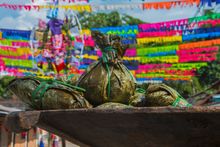 16 Sep 2025
16 Sep 2025
Peru on a Plate: A Culinary Journey Through the Land of Flavour
September 2025 – Peru's capital Lima has truly cemented its star status on the global stage as a gastronomic powerhouse this year with four of the World's 50 Best Restaurants 2025 located in Lima - Maido (1st), Kjolle (9th), Mérito (26th) and Mayta (39th), truly making it a city of international influence. While Lima shines brightly, Peru's culinary story goes far beyond its capital. From the Pacific coast to the Amazon rainforest and the Andes mountains, each region offers a distinct flavour profile shaped by centuries of tradition, biodiversity, and cultural fusion.
Northern coast – where sea meets soul, ocean bounty meets tradition
The cities of Tumbes, Piura, Chiclayo and Trujillo are dotted along the northern coastline and serve up bold coastal flavours. The well-known ceviche takes on a regional twist in ceviche de conchas negras, which uses black clams instead of raw fish. Emblematic dishes of the region include cabrito a la norteña, a warming stew full of flavour and tender goat, and arroz con pato, duck with rice infused with the flavour of the meat and ají amarillo paste, a spicy hallmark of Peruvian cooking. For something to wash it down, there's a traditional chicha de jora or fermented corn beer that is slightly tangy and has a low alcohol content.
Amazonian rainforest – the wild heart of Peru
Further inland, the regions of Loreto, Ucayali, San Martín and Madre de Dios offer exotic ingredients and ancestral cooking methods. Important dishes like juane and patarashca are wrapped up and steamed in bijiao leaves, a traditional Amazonian cooking technique. Whilst juane, consumed on the feast of San Juan (St. John the Baptist), consists of rice, meat, olives, and a hardboiled egg, another version, yuca juane, uses ground cassava instead of rice, freshwater fish, onions and spices. The fish commonly used in patarashca and yuca juane is paiche, a giant fish native to the Amazonian rivers. This ecosystem is at the centre of important sustainable fishing practices that support people of the area. The local indigenous fruits are a must-try - chonta and aguaje, which both grow on palm trees, and the sour camu camu that looks like a cherry and is mainly consumed in juice or desserts. For drinks, try a boozy uvachado made with black grapes, or a chapo made of sweet plantains, cinnamon, and cloves, served warm by the Matses people.
Arequipa – The White City's soul and bold colours, deeply rooted in culinary customs
Arequipa's unique picanterías offer rocoto relleno (rocoto peppers stuffed with a beef-pork mix), solterito de queso (a cold appetiser of cheese, raw onion and tomatoes, corn, olives, and beans), malaya frita (fried flank steak served with white rice and vegetables) or a bowl of chupe de camarones (shrimp chowder) that is perfect to warm the soul. The city's fiery heart cools as the birthplace of queso helado or cheese ice cream, a sweet treat that despite its name is made of milk, vanilla, sugar, dried coconut, cloves and cinnamon sticks.
The Andes – hearty, wholesome and historic
From Cajamarca to Cusco, Andean cuisine is rooted in nutrition and ritual. From quinoa, a globally recognised superfood, to other highly nutritious tubers like olluco, oca, chuño (freeze-dried potatoes) or moraya (white freeze-dried potatoes), grains and herbs are all key ingredients for nourishing dishes. Pachamanca is a roasted meat dish made in a huatia, a traditional earthen oven where food is cooked under hot stones and soil and is part of Peru's national cultural heritage. The elements of this meal have regional variations with differences in the type of meat (e.g. pork and mutton in Cusco or guinea pig, alpaca, pork, lamb or beef in Junin), and the mix of seasoning (e.g. chilli pepper, chicha de jora, garlic and salt in Huanuco or garlic, green chili, huacatay and chincho in Ancash), and are accompanied by traditional Andean crops from potatoes and corn to sweet potatoes, beans and humitas (steamed parcels of corn paste wrapped in corn husk). Another important dish is puka picante, a stewed combination of beets, peanuts and potatoes, that is so important to the city of Ayacucho it was designated its very own day of celebration on the 2nd of February.
Novo-Andean Cuisine – tradition meets innovation
Top hotels and must-visit restaurants have started to reclaim traditional culinary methods from Peruvian pre-Hispanic history, reimagining ancient recipes with modern flair. Dishes include quinotto (quinoa risotto), fish marinated in carob syrup, antojos de queso en salsa de maracuya (cheese and spinach rolls in a passion fruit sauce), cassava casseroles and innovative takes on the famous ceviche.
The wide variety of Peruvian food reflects the diverse landscapes, traditions, and cultural influences and it is this variety that continues to fascinate foodies across the world. Pair this with the unique and modern takes of the dishes in fine dining restaurants, and it is clear to see why this is a recipe for a country that is a leader on the global culinary scene, and at the top of every culinary traveller's bucket list.
For images please see here: Peru on a Plate images or for further destination information and to plan your trip, visit www.peru.travel
-ENDS-
For more press information or images, please contact Barry Johnston barry@goshpr.co.uk, Naomi Man naomi@goshpr.co.uk or promperu@goshpr.co.uk


